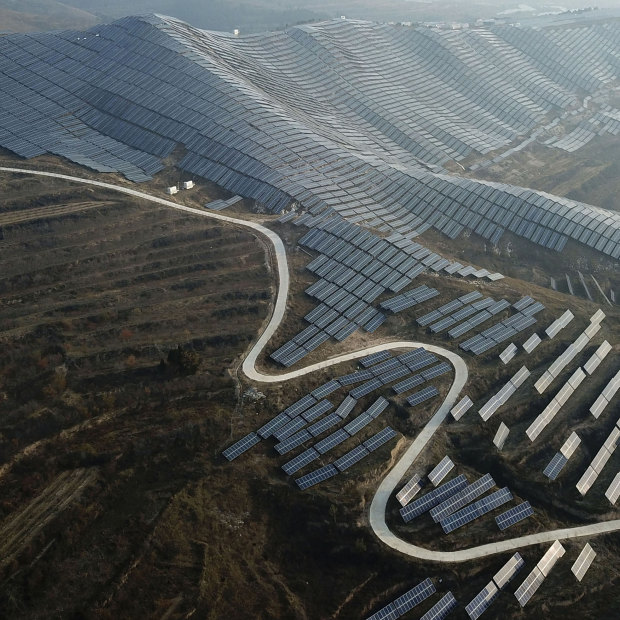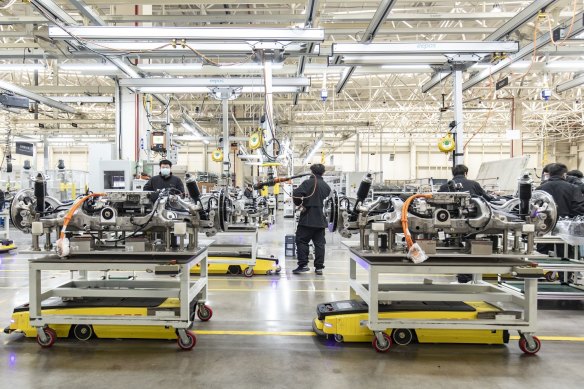‘It’s good news’: Scientists suspect history about to be made in China

China is increasing solar power capacity at a massive rate.Credit: AP
For months, the reports came in and climate scientists and analysts pored over the data. Something unfamiliar was happening. It looked a little like good news. Perhaps even something of profound historical significance.
Ever since the industrial revolution began in the late 18th century, the amount of planetary warming greenhouse gases humans have been pumping into the atmosphere has grown inexorably, causing temperatures to climb dangerously over the past few decades.
Sure, there has been the odd dip over the years, blips that can be seen on a chart, but these tend only to emphasise some other catastrophe: World War II, the global financial crisis and more recently, the COVID pandemic.
As the global order repaired itself, the trend returned, ever upwards.
In 2019, humans pumped 35 billion tonnes of greenhouse gases into the atmosphere. That number fell by a staggering 6 per cent the following year as COVID crunched industrial production and shut economies. At the time, the fall prompted despair in some climate commentators. Is this what it would take to make a dent in emissions? If so, how could such an outcome ever be achieved in a functioning economy?
As the pandemic receded, emissions surged predictably. By the end of 2021, the rebound had bitten. As the global economy restarted, emissions did not just grow; they surged. According to research published in Nature, in 2021 alone, greenhouse gas emissions grew by 4.8 per cent.
Much of this growth could be attributed to the Chinese Communist Party’s determination to return its nation to growth. To end the COVID recession, it kick-started construction of coal-fired power plants and it re-booted its real estate sector, ever hungry for emissions-intensive steel and concrete.
But it is data from the past few months that is intriguing analysts today. The world’s economy is growing. China’s economy is growing. Yet greenhouse gas emissions appear to have peaked.
Some time last year, or perhaps earlier this year, it appears China’s emissions, in particular, reached a high point. If China has peaked, there is good reason to believe global emissions peaked, too. It would mean that some time over the past few months, the stubborn nexus between economic growth and greenhouse gas pollution was snapped, and the 250-year surge in emissions ended.
Lauri Myllyvirta, senior fellow at the Asia Society Policy Institute and lead analyst at the Centre for Research on Energy and Clean Air, was among the first to go public with an analysis showing that China’s emissions might have peaked.
In November last year, he wrote that despite the post-COVID surge in emissions, China’s massive deployment of wind and solar energy, growth in EVs and an end to a drought that had cut hydroelectricity generation had caused emissions to tumble.
“A 2023 peak in China’s CO2 emissions is possible if the build-out of clean energy sources is kept at the record levels seen last year,” he wrote in an analysis for Carbon Brief based on official figures and commercial data.
Largely as a result of the China green surge, global investment in renewable technology in 2023 outstripped that in fossil fuels for the first time, the International Energy Agency reported.
Seen up close, that “build-out of clean energy” has a tendency to astound Western observers.
Last month, Australia’s Smart Energy Council took a delegation to China to visit renewable factories and the Shanghai New Energy Conference, an event that drew half a million delegates.
The group visited an EV manufacturer and saw two lines of production, each spitting out a completed EV every 36 seconds.

Chinese electric vehicle manufacturers are producing cars at breakneck speed.Credit: Bloomberg
The SEC’s delegation including Tim Buckley, founder of Climate Energy Finance, a renewable energy consultancy, speaks of standing in a solar module manufacturing factory owned by TW Solar and gazing down a long corridor, unable to make out its end in the distance. “I saw a long wall, half a kilometre long, of manufacturing lines and not a worker in sight. It was all robots.”
Former Queensland premier Anastacia Palaszczuk, who now serves as an international ambassador for the SEC, recalls visiting a battery manufacturer that had 21,000 people working in its research and development division alone, up from 16,000 last year.
Buckley says this last point is critical to understanding the high-speed industrial revolution taking place.
Each week in 2023, says Buckley, China installed as much wind and solar infrastructure as Australia does in its best year. But without improvements in batteries, that energy cannot be stored and deployed overnight.
This makes China’s advances in battery technology a crucial next step. In May, Chinese car manufacturer BYD announced a new plug-in hybrid car that it boasted could travel 2000 kilometres on a single charge and tank.
The vast investment in battery manufacturing has reduced costs. According to Bloomberg New Energy Finance, over the past year, the price for lithium iron phosphate battery cells in China dropped by 51 per cent to an average of $US53 ($78) per kilowatt-hour. The average global price of these batteries last year was $US95/kW, BNEF reported.
This is not to suggest that China is an environmental white knight, says Buckley. Alongside its renewable deployment, last year, China was building a unit of coal power every fortnight.
“China is acting out of self-interest,” he says. “It wants the coal to power the EVs so it can ween itself off foreign oil. It wants to dominate future industries and advanced manufacturing. The fact that all this has an environmental benefit is icing on the cake for China.”
Underpinning the Paris Agreement is the notion of “common but differentiated responsibilities”. This wording in the language of the treaty acknowledges that while developed nations, which had dumped the vast bulk of carbon into the atmosphere making themselves rich over the past quarter of a millennium, should rapidly cut their emissions, developing nations had the right to peak later in order to lift their populations out of poverty.
Under the agreement, China promised to have its emissions peak in 2030. It appears to have hit that target six or even seven years ahead of schedule.
To Myllyvirta, this is a critical point. Under the Paris Agreement, each nation must keep updating its targets to make them more ambitious. These are known as “nationally determined contributions” and the next round is due at the start of next year. Given its boom in renewables, China is now in a position to ramp up its future targets, wrote Myllyvirta in an analysis published in Dialogue Earth in June.
“The dramatic acceleration in clean energy deployment in 2023 has opened up the possibility of setting more ambitious targets than previously anticipated, both in terms of China’s emissions-peaking timeline and its achievable reductions by 2035.” Should China maintain the trajectory, it would enable emissions reductions of at least 35 per cent from 2023 to 2035.
This would make its goal of reaching net zero by 2060 credible and achievable, writes Myllyvirta. And that would give the world a greater chance of stabilising the climate somewhere near the Paris targets.
Bill Hare, a leading climate scientist and chief executive of Climate Analytics, a nonprofit research and policy organisation, has been watching China closely.
“It’s good news,” he says carefully when asked about the emissions figures. “We are still looking at the numbers from last year, but I think it is happened. If we have peaked in emissions from fossil fuels, and I think we have, this is a historic moment.”
In Hare’s view, the turning point is significant not just for the raw numbers, but because it demonstrates that a generation of difficult diplomacy and politics, of innovation and inventiveness, is starting to pay off in measurable change.
This fact alone should spur even faster global action, says Hare. The cuts are not enough, and they have happened too late, he says, but history will remember this moment.
Hare, who confesses to a cautious sort of optimism, plans to keep watching the data flow in over the coming months. If the trend holds, he plans to crack the champagne by Christmas.
Get to the heart of what’s happening with climate change and the environment. Sign up for our fortnightly Environment newsletter.